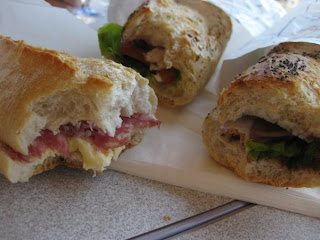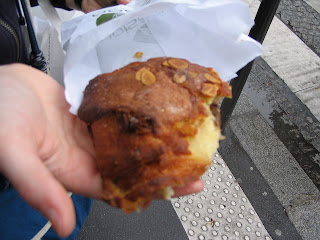
So last week, my boyfriend Pete and I were invited to brunch where we work on a Sunday that we had off. (Read: We actually called, and subtly pleaded for an invite.) Nonetheless, there we were, happily sitting at the corner banquette table, happily munching on scallops and steak and pickled Wagyu tongue (soo good!), when the dessert arrived. We had ordered the season’s blueberry dessert; a trio of blueberry confections with a new lemon pudding that we were anxious to try. We wasted no time digging into the pudding; in fact, I might’ve even stuck my spoon into it mid-air while it was being put down. It was great, not that I expected anything else: it was creamy and tasted of buttermilk with just the slightest tang of lemon. It’s lightness also made it surprisingly refreshing; it’s something I would invite someone in for, instead of lemonade.

Pete loved it. I mean he loved it. He was having a visceral reaction to the stuff. I reminded him, delicately, of the time I made a first-rate lemon birthday cake. I asked him if he remembered how good that was, clearly digging for some compliments, and also clearly a little jealous of the effect our pastry chef had on him.
When we went home that afternoon, my mind was reeling with what kind of lemon tricks I had up my sleeve. I’m not the jealous type, but I’d be damned if I couldn’t make his taste buds swoon like that. Damned. So I set to work filtering through magazines, ultimately deciding on a lemon bread pudding. But I didn’t stop there – I made lemon curd too, the closest you can get to lemon flavor in a bowl. After an afternoon of zesting, grating, and juicing, I ended up with a couple of very lemony, very delicious desserts, and by god, I finally got my reaction out of him.

Lemon Bread Pudding
(Adapted from Gourmet)
Lucky for me, this bread pudding was in Gourmet’s last issue. I halved the recipe and just used a 1 ½ quart ceramic baking dish; I’d say it would serve 4-5 really famished people, 6 people with average appetites, or 8 people who eat like birds (but we don’t like them anyway, do we?).
3 cups thin baguette slices (Any bread will work, just cut into smaller pieces. If it is overly soft, just toast it in the oven for a few minutes – you’ll get a crispier crust.)
1 ½ whole large eggs
1 ½ large egg yolks
1/2 cup sugar plus more for sprinkling
1 tablespoons grated lemon zest
2 tablespoons fresh lemon juice (I doubled the amount of lemon juice and it came out great, but for a subtler flavor, use just 1 tablespoon.)
2 cups heavy cream
Preheat oven to 325° F, with a rack in the middle.
Lie bread, spaced out evenly, in ceramic baking dish. If you’re using baguette slices, you’re going to want to layer it, if you have cubes, just make sure they’re adequately spread out.
Whisk together whole eggs, yolks, and sugar in a large bowl until pale and thick, about 1 minute. Whisk in zest, lemon juice, and cream and pour over bread. Press down with your fingers, or a spatula if you’re dainty, to help bread soak up some of custard.
Lightly sprinkle with sugar and bake in a water bath until custard is barely set and edges of bread are golden, 40 to 45 minutes. (For the water bath, just place your baking dish inside a larger one, and fill the larger one with hot water about half way up the sides of your bread pudding dish.)
Turn on broiler and broil bread pudding 4 to 5 inches from heat until golden-brown in spots, 2 to 3 minutes. Cool to warm, about 30 minutes (pudding will continue to set).
The Gourmet recipe recommended serving this with whipped cream. I didn’t, just because I ran out, but it was just great without it as well. I liked this best served warm, but it was pretty great eaten right out of the fridge, too.

**For the lemon curd, I used David Lebovitz’s recipe for his lemon tart filling. You can find it here.














